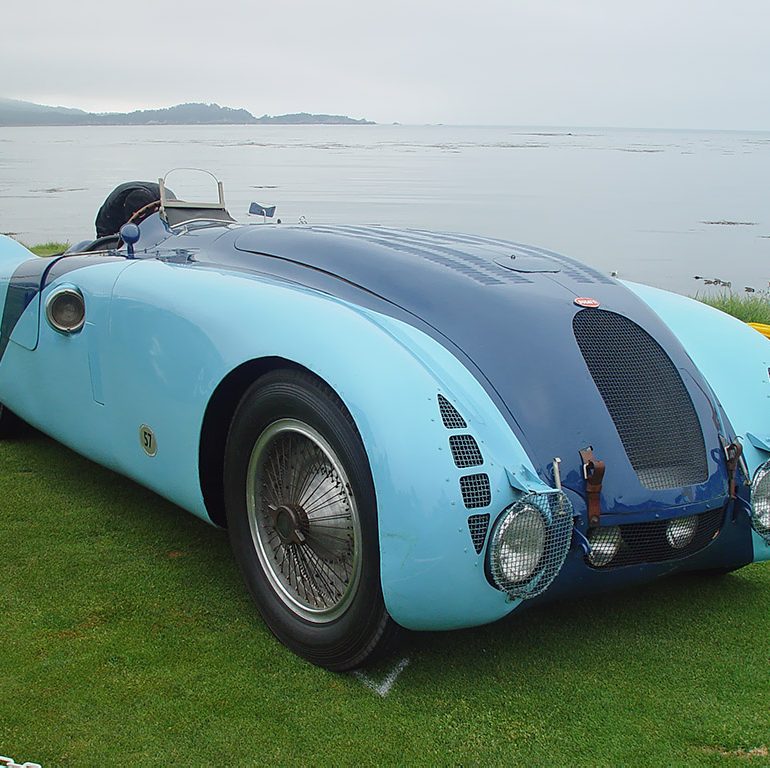1936 Bugatti Type 57G Tank
Even through Ettore and his son Jean built the Type 57 as a road going supercar, they couldn’t resist proving it on the track. In the first year of production, competition versions of the Type 57 with streamlined bodies were raced in Tourist Trophy.
The following year, in 1936, an extremely different competition Type 57 appeared called the 57G. It featured fully enclosed bodywork that gave the car its tank nickname; a title first given to the Type 32. The newer car, however, featured much more elegant lines more akin to Bugatti design. For cooling purposes, the body of the car was heavily cutup with extra ventilation in the engine bay, front section and underbody.
The Type 57G remained similar to the road car’s engineering. The motor was mildly tuned, but not supercharged. Type 59 GP wheels were installed.
When the 57G first appeared, it was sensation within the racing community. Bugatti proved the car at many different Grand Prix events, and even won the French Grand Prix at Montlhery due their slippery aerodynamics and light fuel consumption. The following year, at the 24 Hours of Le Mans, Jean-Pierre Wimille and Robert Benoist drove a Type 57G car to victory at Le Mans at an average speed of 85 mph.
A special version of the 57G, called the Type 57S 45 was prepared for the 1957 Le Mans. It used the type 50B engine which was reported capable of 470 horsepower. It featured extra cooling beside the radiator hole and no apertures in the front wings. Unfortunately, the car only ran in practice and saw little competition thereafter.
After Bugatti’s absence from the 1938 Le Mans, Jean finally convinced Ettore to race a single entrant in the 1939 race. The car was a ‘tank-line’ Type 57C, being much longer than the Type 57G. After Louis Gerard in his Delage retired, Wimille and Veyron were drove to victory and took another Le Mans win for the Type 57 chassis. Tragically, Jean Bugatti died testing the winning car on August 11, 1939. The car was never rebuilt.
Chassis 57367 is the sole survivor of three Tanks made in 1936. It is also one of the most important Bugattis, as this chassis, #57335, won the 24 Hours of Le Mans in 1937. Before this victory, the car won the French Grand Prix, the Grand Prix de la Marne and the Grand Prix de Pau. Currently, the car features its original body and is a highlight of the Fred A. Simeone collection.
Pictures & Gallery
See full 1936 Bugatti Type 57G Tank Gallery here
Specs & Performance
| type | Racing Car |
| built at | France |
| production | 3 |
| engine | Inline-8 |
| position | Front Longitudinal |
| aspiration | Natural |
| valvetrain | DOHC, 2 Valves per Cyl |
| displacement | 3257 cc / 198.8 in³ |
| bore | 72 mm / 2.83 in |
| stroke | 100 mm / 3.94 in |
| power | 149.1 kw / 200 bhp |
| specific output | 61.41 bhp per litre |
| bhp/weight | 158.1 bhp per tonne |
| body / frame | Aluminum over T57S Steel Frame |
| driven wheels | RWD |
| front tires | 28×5.5 Bugatti Racing Wheels |
| rear tires | 28×5.5 Bugatti Racing Wheels |
| front brakes | Drums |
| rear brakes | Drums |
| curb weight | 1265 kg / 2789 lbs |
| wheelbase | 2979 mm / 117.3 in |
| front track | 1349 mm / 53.1 in |
| rear track | 1349 mm / 53.1 in |
| transmission | 4-Speed Manual |







